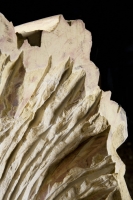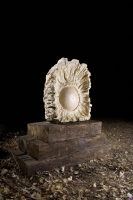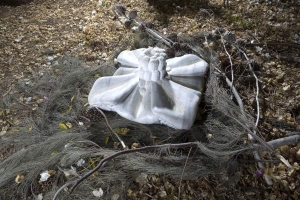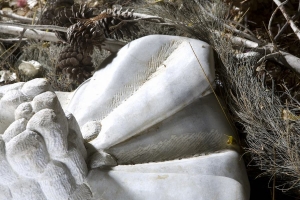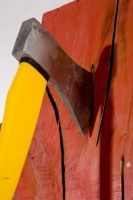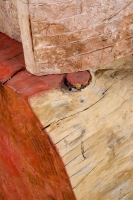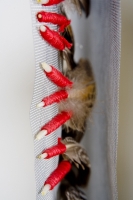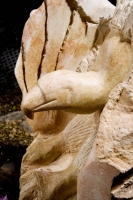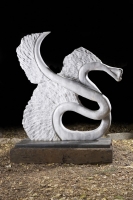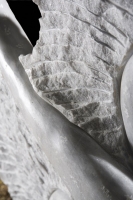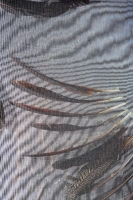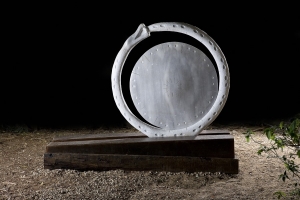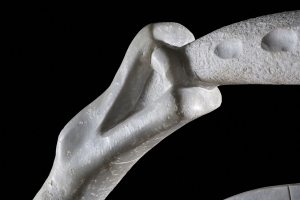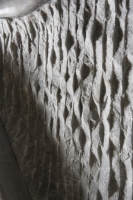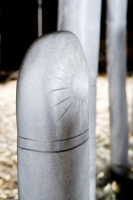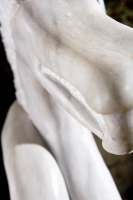Going West
Avi Sperber is not a spontaneous artist. His work consists of thorough research – formulating an idea and planning his work to a point that one feels that when he chooses a stone, he already visualizes the finished sculpture in full detail. Indeed, one has the impression that Sperbers’ sculptures are exposed from within the stone – as if they were there all along and he just revealed them.
Sperber works in series and themes, dealing with man and nature. He expresses his ideas through symbolically charged images. This is a semiotic approach to art – assuming the existence of meaningful cultural signs that do not need explaining. The symbolic meaning of the snake, for example,or the pomegranate, is obvious to every member of the Jewish/Israeli culture.
This exhibition, “Going west”, is different from Sperbers’ previous shows inasmuch as the symbols that he uses are from a different culture and a key is needed to understand their context.
Sperber connects the symbols from the ancient and lost Aztec culture to our own through the image of the sun that goes down in the west and is, according to Sperber, an analogy of the declining Western culture that has always been a source of attraction to us in the east.
Stern gallery is happy to host this exhibition that connects past and present and as such coheres with our concept in the past decade of juxtaposing classic and contemporary art.
This is the first sculpture exhibition that we are presenting in our garden.
Debby Luzia
Stern Gallery
"Going West"/The Series of works at the exhibition
Man tries to interpret and understand strange phenomena that he encounters and has the need to communicate with his fellow man and with reality. If the culture and language are not understood – man prefers to invent the interlocutor. According to Nahum Meged from the Hebrew University of Jerusalem, this was the result of the meeting between Cortez and Moctezuma – a well known story in the history of Mexico. Two different worlds meet on the shores of Veracruz in the Gulf of Mexico and later at the city of Tenochtitlan, Language, World view and outlook on life separated them. The Indians lived in a world steeped in myth and were surrounded by hundreds of Gods. Spirits and higher powers. They saw the Spanish as unknown creatures in their shape, color, dress and food they brought from the sea, from the “Floating towers”. Strange animals joined them and were used to carry things. The white body was covered with a heavy cloth made of shiny metal similar to the chair of the Sun God, who were these newcomers? – asked Moctezuma, his ministers, generals and his people.
A whole period came to an end at this time. The Gods reexamined creation in order to decide if, in their infinite kindness, to grant another 52 years to the inhabitants of world or to destroy everything. The end of the present “fifth sun”, the sun in motion, was ruled by the God represented by the feathered snake. Quetzalcoatl, who predicted the coming of a new power. Even the king saw in the Spanish a blessed power that came from the sea. They thought that the newcomers were simply the God Quetzalcoatl, the king-priest who left his followers to the land of eternal wisdom.
Anticipation and fear spread, the return of the king to his new royal throne meant a change in the laws of nature. None of the subjects who prayed for his return wanted the known world to change. They wanted, but didn’t want his return. Moctezuma was sure that there was no point in sending his waiting soldiers to the mountain passes in order to attack the advancers. What could they do to a God and his escorts? He refused hear that these were cruel strangers and not messengers of the Gods.
Moctezuma sent magicians, who cast spells, broke eggs, slaughtered chickens and sacrificed animals – to no avail. The horses and their riders closed in on the capital. The Spanish Cortez’s soldiers and priests, could not understand the nature of the people that stood before them. The Aztecs saws the Spanish as Gods, while the Spanish saw the Aztecs as the offspring of the devil. Cortez burned both people and holy books. In his absence, his soldiers butchered the dwellers in the temple of the omnipotent God – Huizilopoztli. When the imprisoned king Moctezuma was murdered and humiliation knew no boundaries, the Indians realized their error and mistake. The kingdom of Cortez spread in every direction. This new Spain was now termed the “New World”.
In his present exhibition “Going West”, Avi Sperber uses the design of his stone sculptures to visually demonstrate to the viewer in a clear and three-dimensional way some of the symbols and terms borrowed from the ancient culture. The installations and original creations, which were preserved for hundreds if not thousands of years, were destroyed by the white man in his expansion westwards. The destruction of the Native In Americans included the destruction of their culture, houses, temples, statues and rare art works. This current exhibition uses this example as a warning for the future of man on the planet, who in his quest for expansion west, endangers his very existence. Without the past there is no future and vice versa – without thought and worry for the planning of the future, there is no point in remembering the past.
The last of the Mohicans
The picture of the Indian in the eyes of the west was formed without regard to real Indian culture, having been based on images drawn up by Europeans such as the German author Carl May, who never actually set foot in the “Wild West”. The American author James Fenimore Cooper the coined phrase “The Last of the Mohicans” – the title of his famous book, and wrote about the lives of the Indians from stories he had heard.
These stories later defined a people on the verge of extinction. in the installation, the “Last of Mohicans” is not physically present. He stuck his spear, hung his feather headdress on a hanger and left.
The song of the wind
The eagle and the snake describe the Indian’s world. Between them the wind blows – the breath of the world and the flow between man and nature. Similarly, man’s breath a conceptual element connecting him to nature. They believe that when a man dies, his soul (spirit) withers. In Hebrew, the word “Ruach” has meanings connected with the flow of air and with the essence beyond the body – the spirit. Ruach also has meanings beyond the existence of the unknown. In Indian culture each man had a protective spirit in the form of an animal – a parallel spirit to his own. When someone suffers, his protective spirit suffers as well and vice versa. Thus, a direct link exists between man and beast. The Indians believed that man is a part of nature and has no rights over other creation – he is just one more and all are equal.
Time Returning
The Mayan calendar was composed of two tables. The days of the year were named accordingly. The overall shape was similar to a set of cogs. A full cycle returning to a day with a similar name took 52 years. The Mayans observed the stars, planets and solar system and consequently could predict the length of the day and the year more accurately than the Gregorian calendar. This was of the utmost importance for their religious rituals. The Mayans did not see time as an infinite vector, but as a rolling system that repeats itself. Nature is a treasure of time. Over time it is consumed. But we that claim the world is moving forward to progress – are we in fact leading it backwards and eventually time reset back of its beginning? The sculpture describes the calendar wheel turning within another wheel that looks like a snake that swallowed its tail – Ouroboros, The ancient symbol of the cycle nature and reoccurring processes.
Going West
The red sun in the west symbolizes the westerly direction, sunset and the end – death. The Mayans and Aztecs believed that in order for the sun to return and for the Earth and the stars to continue moving, human sacrifice had to be made because only that which exists can bring something new.
Eagle/ Serpent
For the Mayans, the eagle symbolized the sky, the dwelling place of the Gods. The snake symbolized Mother Earth and the underworld. Mother Earth raises each plant and child with tenderness, but also swallows life – this is how life is conducted in nature. Together, the eagle and snake stand for the entire known world. According to legend, the Aztec chose to build their cities where an eagle’s head was seen in a snake’s mouth. This is the symbol of Mexico to this day.
Peyote
The ancestors of the Mayans, the Indians, still use hallucinogenic plants in shaman ceremonies. They see Peyote as a living plant full of wisdom that leads to other worlds. These plants are also the gateway to unknown worlds located beyond consciousness in the installation, the Peyote flower is combined with a compass rose and is placed on a pine branch symbolizing the connection to natural, which is a significant foundation in Indian culture. When man speaks, nature answers and when nature calls, man answers.
Quetzalcoatl
Quetzalcoatl is the beneficiary God who created man and provides food for all creations. His symbol is the feathered snake and some say he is the God of dual existence living in both the red and black land (land of life and death). According to Aztec legend Quetzalcoatl was supposed to return the year that Cortez in fact reached Central America this belief was one of the reasons for the fall of the Aztec empire.
Chief
For westerners, one of the most striking images of the Indian is the Chief – the feather adorned leader of the tribe. The installation is a sort of memorial to the extinct and a warning about the dangerous situation of the planet’s natural resources. A pillar, a pine log painted red with axe marks burned in black is in accordance with Mayan belief that collective memory is written in red and black ink, which are the signs of sunrise and sunset, life and death, because the world exists between these two colors. The axe was used by the Indians for hunting and for their war of survival and is also used to cut down for the forests and bring destruction to the Earth.
The corn people
Since according to the Mayans, time repeats itself, then so does creation. The world is destroyed and recreated by the Gods in every age. Man is also recreated and each time the Gods try to make man out of a different
material in order to create one they will like who can bring them their food. Until the year 2012 we were in age where man was created from corn and this is why Mayans call themselves men of corn. Corn has 4 colors: black, red, yellow and white, in accordance to the races of man. Studies have shown that the Mayan kingdoms vanished not due to war but because of deforestation in order to grow food, mainly corn. According to the Mayan calendar, the current age has been end in 2012 i.e. the world destroyed and recreated. The installation presents a group of decorated stone poles, two in red and decorated like corn. The poles are on a floor covered on pine needles as a metaphor for a crowed praying at a temple or a church, which is to this day covered in pine needles.
The Ball Game
The Mayans used to play a ball game – a game of gladiators played with rubber ball where the winner won life and the looser, death. The installation is composed of a seesaw of the trunks on which two halves of a stone ball have been placed, symbolizing the Earth and the delicate balance in which the planet lies. Indian culture did not see good fight evil in order to win. Evil was part of life as was darkness and the need for a delicate balance between things in order for the world to continue. Western culture only measures the advantages in economic growth and is depleting all the natural resource and polluting the planet. It is not taking into account the damage being casual and needs to change its thought process to a more delicately balanced distribution of resources. The seesaw is crossed by a net, similar to a volleyball net, in which feathers are hung as a metaphor for birds and extinct species in their flight towards the west (death). The wood is adorned with jaguar skin as a tribute to Jorge Luis Borges’ story “God’s Words” from his book. “The Aleph”. These symbols are the secret word to be used to save the world, which however will never be spoken – and so its fate is destruction, it will not be saved.
Remarks on the Launch of the book “Going West”
My first meeting with Avi Sperber took place more than ten years ago. We drove to Ein Hod, where he was working, mainly creating solid stone sculptures in the workshop of the late sculptor Tuvia Yuster.
I was very impressed with his work and his art, and after seeing it there and visiting his exhibition in Artists’ House in Haifa, I curated the exhibition entitled “Insane Homeland”. The exhibition featured fruits: a cluster of grapes and pomegranates of enormous size, which expressed, in their arrangement, the fragrances and flavors of our familiar homeland. The central-focus of the exhibition is a large installation, a field of sheaves — an amazing arrangement of numerous sheaves heads that were placed on high metal staves, an expression of an historical “aspiration,” to wards off the unfortunate destruction by developers occurring today – an “improved” landscape of our country, laying waste to a land and flow of milk and honey.
Avi invited me to other exhibitions of his over the years. After about a decade, there was no doubt that in terms of form, his works in stone became stylized, polished, and sophisticated, an impressive demonstration of the control the sculpting in the sculpting of images and objects.
The dominant character of stone does not limit him. On the contrary, Avi subjugates the stone and controls it with a iron hand. We will find him sculpting marble in the smallest detail, or in parts and subduing the rock with delicately abstract carving.
His works are typified by a merging of various cultural sources. In the current exhibition, his sculptures draw inspiration from the culture of the past and their link to the culture of the Maya and the Inca tribes of South and Central America, with a direct link the present.
Avi Sperber works with artistic is freedom and spiritual overtones that consistently characterize him, especially in this current exhibition. The sculptures contain a symbolism that draws its inspiration, from the cultures mentioned, while emphasizing various aspects and materials that are then integrated into a perfect form.
The combination of materials such as wood, fabric, native American feathers, and so on, are materials that draw him to make full use of the symbolic complexity of the subjects of the works.
A strong undertone an introduction to the sculpture of the chief in its red hues and the symbol of an axe above it, with the background of wood — a symbol of the native American tribes that is engraved in our memory. The sculpture of the blazing, red sun — as a background to the offering of sacrifices, astonishingly carved and polished in marble.
Two motifs that are held sacred as divine — the snake and the eagle, living creatures that represent the two poles of the earth. Earth and heaven, worked and carved in amazing detail — the eagle that embraces with its wings and appears as an exalted creature, and the curving snake, polished and sophisticated works, with impressive wood carving in the background.
At the center is an installation that represents the population, the inhabitants who are nourished by the corncobs, who are gathered like a community in a wood like image of corncobs left behind as remnants and reminders of a glorious culture.
The sculpture that is assembled in the form of a wooden swing with globe-shaped half-containers of stone that represent our planet, and the delicate balance in which it exists. According to Mayan belief, evil is part of the universe’s continued existence. The net that is spread out as crossing, with images of feathers upon it, is like a mirror that illustrates, in the current reality, the extinction of various fowl in flight, as a symbol of death. This sculpture, the most complex of all, combines many types of material.
On the other hand, the sculpture that I feel is the most important, and that embodies the topic of the exhibition, represents the cycle of life, the code at the basis of creation. Death and life, which hold one another in a harmonious, circular flow. Inspired by the Mayan calendar, which was set according to the planets and the solar system. Worlds of creation renewed in two circles sculpted in aesthetic precision and in pure and pristine symbolism.
In summation Avi Sperber’s vast experience in creative work in sculpture has endowed him with ability that is clearly imbued in the current exhibition. He brings to life symbolic spiritual visual messages that are formed in different ways. This, perhaps, is where his power lies, which is embodied and revealed in his works and reflected in his book.
I would like to give special thanks for having been invited to say a few words about his artistic work and talk about the spiritual symbolism in his sculptures, particularly in this exhibition, on the occasion of the launch of his book, Going West.
Ina Aroeti, curator
The Constant Sculpture Gallery, Ramat Gan
Stone-Speak: Avi Sperber’s Sculptures: A Personal Observation
Avi Sperber’s beautiful stone sculptures are not confined by the artist’s definition of what they signify. Art is in its simplest terms an integration of the individual (artist) and for the universal (the artwork) and the meaning brought to it by the observer. Here I observe Sperber’s work in a way less restricted and less polemical and more universal than the artist himself does.
Sculpture is above all art dependent on material. In sculpture the material bears a message and its choice defines its meaning. Stone speaks for itself. No material has been to man’s expression and more universal over the eons of his existence: First as the substance of tools – made by us and what we are – then as material for shelter, and ultimately as the fabric for the realization of the spiritual in the physical.
Stone speaks loudly with its silent voice of man’s religious guest the many distant generations. From the 25’000 years old “Halstadt fertility God”; to the Canaanite lions of Hazor; from stonehenge to the giant heads of Ester Island; from the Greek and Roman deities to the father of the Church itself, Peter, whose name means rock – stone in its immortality has been the material on which man chose to carve his spiritual guest. This is no more so than among the indigenous peoples of South America, the Inca and Aztec, who wrote depicted their gods in stone carved friezes on their many temples.
It is appropriate that Sperber has choose stone to express the universal message embodied in his carved symbols.
They belong to our world no less that of the North American Indian and to other indigenous peoples. For we were all once an indigenous peoples. They are the generic symbols of pre-agricultural mankind derived from nature and present among all cultures. In that regard they are evocative for a “Western” audience.
No matter how distant from our own present moment in time, we too in our far past in such a culture. Those images and those values yet remain deeply imbedded in our cultural subconscious and physical instincts, even as we choose to ignore them.
Thus quietly as the stone itself, we relate to Sperber’s sculptures knowingly and nostalgically recalling a world when we too lived in harmony with our environment. Today the sculpture remind us of our own distant past-symbols are those of the Native American – but they may have been carved, as well, on the cave walls of Lascaux in France some thirty eons ago.
The beauties of the sculptures are self evident and their message, we can all acknowledge, is imperative one-even as we choose to admire the sculptural from and ignore its substance. Sperber has chosen the American Indian as his subject, but his symbols are far more universal. The depredation of the American Indian is well known today.
But our ongoing lack of respect for indigenous cultures merely mirrors our divorce from the natural world, whose echoes remain “carved in (Sperber’s) stone” and whose victims we join.
Michael Sternberg
Multinational Force and Observers, director-general’s representative in Israel
